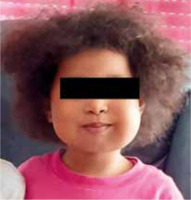Dear Editor,
Respiratory complications are one of the main problems in paediatric anaesthesia. Cherubism is a rare fami-lial disease causing enlargement of the mandible that may be associated with difficult intubation [1, 2].
A 5-year-old, 20 kg, ASA 1, healthy girl was evaluated for anaesthesia requested for the removal of mandibular lesions (Figure 1). She had a positive family history of cherubism; her father and cousins were affected. Radiogra-phically, the lesions demonstrated multilocular, expansile radiolucencies with mandibular enlargement. The preoperative examination was unremarkable: normal neck flexion, no trismus, and a Mallampati score of 1. A venous catheter was inserted peripherally under N2O inhalation and transdermic lidocaine and prilocaine patch. The general anaesthesia combined sevoflurane and IV sufentanil. Nasotracheal intubation under direct laryngoscopy was uneventful. After the surgery, which lasted 120 minutes, she was admitted to the post anaesthesia care unit for 1 night and discharged the next day without any sequelae.
The anatomy and physiology of children’s respiratory systems predispose them to the development of potential complications. With apnoea or insufficient ventilation, hypoxaemia develops more rapidly [2]. In fact, children have a minute ventilation/residual functional capacity ratio of 5/1, as compared to 1.5/1 in adults. The shape of the airways is also different: the trachea is relatively shorter and narrower, and in children under the age of 10 years, the narrowest part of the airway is located under the vocal cords, near the cricoid cartilage [2].
Cherubism is a disease of autoso-mal dominant genetic origin and variable expressiveness, characterized by abnormal development of the jaw, ori-ginally described by Jones in 1933 [3]. Clinical manifestations begin between 2 and 5 years of age and generally progress until puberty, then remain stationary or even regress [2]. The cherub-like face results from bilateral involvement of the posterior part of the mandible. A painless bilateral expansion of the posterior part of the mandible results in fullness of the lower third of the face and retraction of the lower eyelids, resulting in a characteristic “eyes toward heaven” appearance [2]. Radiographically, the lesions are typically multilocular, expansile radiolu-cencies [2]. Cherubism is often associated with progressive gingival enlargement, which ultimately limits normal closure of the jaw. It can be associated with other malformative syndromes (Ramon, Jaffe-Campanacci, Noonan). Airway obstruction can be a major source of morbidity when the tongue moves, affecting speech, chewing, swallowing, and breathing [2]. Surgical treatment requires surgical dissection of the mandibular lesions. The procedure is performed under general anaesthesia with the particular requirements of paediatric surgery [2]. It is preferable to have a peripheral venous approach by combining a transdermal anaesthetic device and inhalation of nitrous oxide before inducing general anaesthesia: nasotracheal intubation frees up the mouth space for the operator. Postoperative monitoring in a continuing care unit for at least 1 night is desirable to detect a possible respiratory complication (oral or cervical haematoma). In contrast with a previous report, which described complications in an older girl [4], we suggest operating such a patient early in childhood, which may be associated with better anatomical conditions in terms of intubation. Familial consent was obtained to publish this case.





